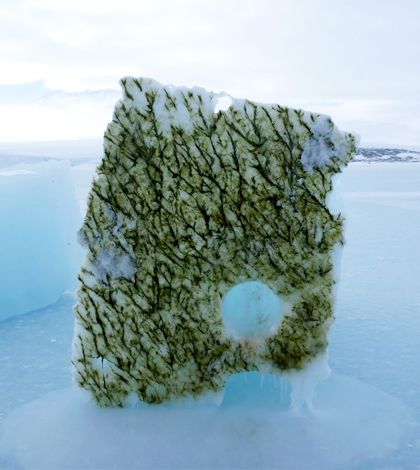Retrofitted drone lets researchers more easily study algae growing beneath Antarctic ice

Researchers from Denmark’s Aarhus University looking beneath meters-thick ice in Antarctica using an advanced underwater drone found colonies of algae carving out a prosperous existence where most life would wither.
The findings reveal that algae plays an important part in the Antarctic ecosystem, and that life as we know it can survive — and sometimes thrive — in some rather unlikely places.
According to Lars Chresten Lund-Hansen, associate professor in Aarhus University’s department of biosciences, a previous study in the Arctic inspired the researchers to perform similar work in Antarctica. The acquisition of an underwater drone provided the researchers with a chance to test new methods of mapping ice algae in otherwise unreachable areas.
For five to six months each year, ice covers much of the ocean around Antarctica. During this period, algae is the only thing that grows, absorbing scant solar radiation through the thick sheets. But in spite of limited resources, algae can form impressively large mats on the underside of the ice. Krill and other zooplankton use the algae as their sole food source for the ice cover period, providing sustenance in turn for fish, and then seals and birds. In a place that should be devoid of life, algae makes living possible.

Researchers deployed the drone through holes they drilled in the ice. (Credit: Lars Chresten Lund-Hansen)
The significance of algae and the allure of its unexplored aspects compelled the researchers to work, shivering, on the world’s only stateless continent, next to the same hut that polar explorer Robert Falcon Scott inhabited during his expeditions at the turn of the century. The work wasn’t easy and the days were long, Lund-Hansen said, but the rigorous pace was necessary.
“It’s very expensive to do this research, so we have to use the time we have,” he said.
Making the most of their time meant rising at 7 a.m. for a quick breakfast and planning session, then an over-ice snowmobile trip to the field site. The researchers split into teams, one working with the drone and the other coring and sampling ice and the algae residing beneath it. After lunch, the researchers continued to work until heading back to camp for a late dinner at 8 or 9 p.m. A de-briefing and an overview of the next day kept the researchers busy until they could crawl, exhausted, into their sleeping bags around midnight for a little sleep before restarting the process.
Originally designed to study the seafloor, the drone was refitted with an upward-facing camera to get a better look underneath the Antarctic ice. To deploy the drone, the researchers drilled a hole through the ice with a steamer, pitching a heated tent to keep the hole from freezing over. The researchers would soon find that other Antarctic denizens employ ice holes of their own, though theirs don’t have the luxury of heating.
“When we finished raising the tent, we suddenly heard some very strange sounds and splashing from the hole,” Lund-Hansen said. “We saw a very big (500 kg) Weddell seal in the hole.”
“They have holes in the ice for breathing… but clearly our hole was much better, with heating and a comfortable size,” he said.
The seal didn’t seal the opening indefinitely, however, and the researchers managed to deploy the drone under the ice. Using drones, Lund-Hansen said, allows the researchers to cover a much larger area in a much shorter time than traditional coring methods. In one of the world’s most expensive field laboratories, saving time is saving money, and saving money is attractive to potential funders.
Lund-Hansen and the other researchers plan to work with the drone beneath the ice sheets of Greenland. But the lush, green mats of algae beneath the lifeless Antarctic ice still stand out in Lund-Hansen’s mind.
“I have never seen anything like it,” he said.
Top image: Algae living beneath the ice. (Credit: Lars Chresten Lund-Hansen)





0 comments